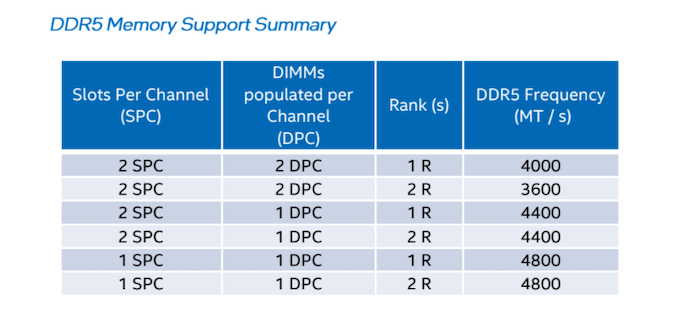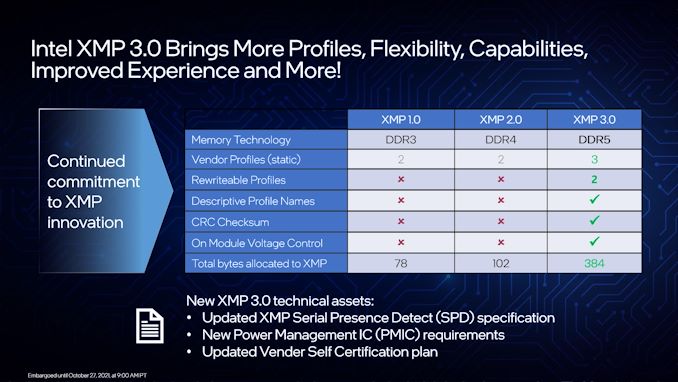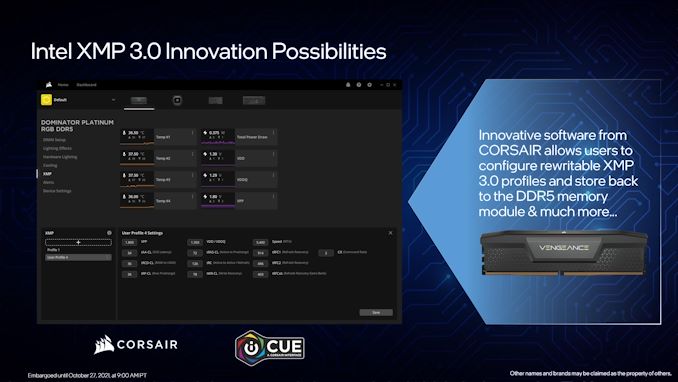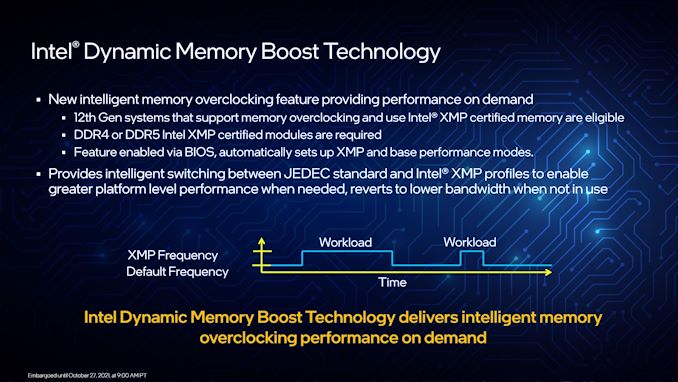Intel 12th Gen Core Alder Lake for Desktops: Top SKUs Only, Coming November 4th
by Dr. Ian Cutress on October 27, 2021 12:00 PM EST- Posted in
- CPUs
- Intel
- DDR4
- DDR5
- PCIe 5.0
- Alder Lake
- Intel 7
- 12th Gen Core
- Z690
Memory: Varies with Number of Modules
Inside each of the Alder Lake processors are memory controllers for both DDR5 and DDR4. Unlike previous generations, we’re unlikely to see motherboards supporting both types of memory. We understand that Intel has explicitly requested this – we didn’t see many retail combo boards in the DDR3/DDR4 era, so expect to see fewer this time around (although you can imagine someone will eventually do it). There is a slight technical reason too – DDR5 uses onboard power management, while DDR4 requires that from the motherboard, something which is hard to implement without wholly independent traces for both. If Intel is saying both cannot be done at the same time, then it’s likely that this is a unified DDR4+DDR5 controller that shares an amount of logic internally, but only one can be used at any one time.
Intel lists the specifications for its memory support as DDR4-3200 and DDR5-4800, and as always memory support is listed as conforming to the JEDEC implementations. This means Intel qualifies DDR4-3200 CL22, and anything above that is technically overclocking the CPU – it’s actually hard to find consumer memory at this speed these days. For DDR5, there are actually three specifications here:
| DDR5 JEDEC Specifications | |||||||
| AnandTech | Data Rate MT/s |
CL |
Peak BW GB/s |
Latency (ns) |
|||
| DDR5-4800 | A | 4800 | 34 | 34 | 34 | 38.40 | 14.17 |
| B | 40 | 40 | 40 | 16.67 | |||
| C | 42 | 42 | 42 | 17.50 | |||
We clarified with Intel that the processor supports all three, with the top being DDR5-4800A CL34. This is despite Intel shipping DDR5-4800B CL40 with their press kits, but I digress.
The thing with memory support is that it usually quoted for a specific number of modules installed into the system. In this case, Intel is quoting these numbers using one module per channel (technically a 64-bit channel, but more on that later), meaning that these are the supported speeds when two memory modules are supported. The official supported speed changes if you have more memory, double-sided memory, or dual rank memory.
We’ve seen this before – server processors are notorious for having slower support when more memory modules are installed. It turns out the more bandwidth you need, the harder it is to keep that speed with higher capacity memory. It was only until Intel’s 11th Gen Core products that the memory design supported DDR4-3200 regardless of configuration, because sometimes that’s how long it takes to optimize a memory controller. For Alder Lake, DDR4-3200 is also supported in any configuration, but DDR5 changes depending on the memory.
Intel shared this table with us.
If the motherboard has two memory slots total, then the maximum support is DDR5-4800 in any configuration.
If the motherboard has four memory slots total, then the maximum support is DDR5-4400 when two slots are filled with any memory.
If all four memory slots are filled, single rank memory will support up to DDR5-4000.
If all four memory slots are filled, dual-rank memory will support up to DDR5-3600.
So technically Intel listing memory support on Alder Lake as DDR5-4800 is a bit of a misdirection compared to previous launches. If we were to look at parity, two modules in a four-slot board, then really we’d be quoting DDR5-4400. Funnily enough, all of Intel’s benchmarks presented at this launch were run at DDR5-4400, as per specification. Kudos to the testing team to staying within those guidelines.
A side note here on memory channels as a whole. In the desktop space, we’re used to one memory module having memory for one 64-bit memory channel. That’s true for DDR4, DDR3, DDR2 etc, but the DDR5 specifications move to 32-bit memory channels. So while each DDR5 module is still using 64-bits of bandwidth, there are technically two 32-bit memory channels worth of memory on each module. This can create a little bit of confusion, because it means that Intel 12th Gen, while still a 128-bit memory interface as previous generations, it uses 4x 32-bit channels, not 2x 64-bit. Undoubtedly companies (even Intel) still call this dual-channel, as a channel is usually inferred to be a 64-bit interface.
There is no easy solution here. 2DPC (two modules per channel) doesn’t really mean much if technically channel there infers 64-bit but you’re running on a 2x32-bit channel system. Some users are calling a DDR5 module a ’channel’ with two 32-bit ‘sub-channels’, although that is more a twisting of reality, given that sub-channels are often something else in memory design. Because we’ve used the word ‘module’ to imply a 64-bit channel for so long, and because memory can be installed with more than one module per 64-bit channel, it’s actually a mess in English to find not only the correct words but also ones simple enough to not make the situation overly complex. Perhaps it’s time for some new words.
Memory: XMP 3.0 and Better SPD
One of the new features with DDR5 is the expansion of Intel’s eXtreme Memory Profile support. Now moving to XMP 3.0, it increases flexibility for both users and vendors by increasing the number of profiles per module, opening up for customization, and improving the overclocking experience.
Memory vendors when they ship the memory will embed in the memory firmware a series of specifications, known as SPDs. For standard memory running to JEDEC specifications, the module will likely contain SPD profiles relating to something slow for underlying support, and then up to what the memory chips were sold at – depending on the motherboard, the system then picks the JEDEC SPD profile that best fits the processor (I’ve seen a wild variety of implementation here, funnily enough.
XMP goes above and beyond traditional SPD support.
XMP 2.0 on DDR4 contains up to two additional SPD profiles with overclocked values. For example, a DDR4-4000 CL16 memory module might have three profiles total – one at 2133 CL15, one at 3200 CL22, and a third XMP profile at 4000 CL16. It is up to the user to then select that profile when in the BIOS or through additional software. If the module has two XMP profiles, perhaps one for latency and another for bandwidth, then this can be done in XMP 2.0.
The update to XMP 3.0 allows for five profiles, rather than two. Three of these profiles are memory module vendor locked, limited by whatever they come out of the factory at. The final two profiles can be used by the memory module vendor, but are re-writable by users in order to save overclocking settings. These profiles can also be named to be descriptive.
Intel states that this re-writing process is backed by a rigorous checksum support so users can’t brick their hardware. For most situations, that’s going to be reasonable, however if that security does get broken, it might be advised that if you buy second-hand DDR5 to erase those profiles and not use them. Just in case it overvolts the memory controller to 3 volts, or something.
Alongside more profiles, because DDR5 moves the power management for the module onto the module itself, if a memory vendor uses a ‘better than base’ solution then users can adjust various voltages and timings on a per-module basis.
Both the profile expansion and the updated voltage controls are also now exposed to the operating system in such a way that allows for better software implementation. Users with Corsair memory, for example, can use Corsair software to adjust the memory on the fly and monitor temperatures, power, voltages, and also keep track of how they fluctuate during overclocking, testing, or normal use. There is also another new feature, allowing users to adjust memory frequency on the fly, which has never been seen before. We’ll cover that in the next section.
On a more ecosystem level, we confirmed with Intel that XMP 3.0 is a self-certification procedure at memory vendors, with no additional licensing costs to the vendors.
Memory Gets Turbo: Dynamic Memory Boost
One of the persistent features with memory over the years is that when you have settings saved in the BIOS, they are ‘trained’ (tested to work) when the system boots up, and then that’s what you have for the whole time that the system is turned on. It never slows down, it never duty cycles to reduce power – it has been very consistent for a long time.
With Intel’s Z690 boards and 12th Gen Core Alder Lake processors, that changes. Much like processors and graphics have had idle states and turbo states for generations, memory now gets it as well.
This first-generation technology is basic, but a start. A 12th Gen system, as long as it runs DDR4 or DDR5 memory with XMP, can define two of the onboard SPD profiles – one as the base, and one as the turbo. Usually the base profile is one of the immutable JEDEC profiles, and the turbo is an XMP profile. But when activated, the system is able to switch on the fly between the two, activating when a workload is initiated for higher performance, and supposedly better idle efficiency.
There are a few thoughts or questions on this worth noting:
#1: It works on DDR4? Intel says yes. This makes it sound like this is more of a software/firmware innovation than a hardware innovation, or it requires the right hardware on the CPU at least. No doubt if it works, it will become ubiquitous.
#2: Isn’t power efficiency really for benchmarks and laptops? I agree with this one, and expect it to be more of a highlighted feature when Alder Lake comes to laptops and notebooks. That being said, most notebook DRAM is JEDEC anyway, so it might open the doors for better-overclocked notebook memory if it can retain the battery life of a base JEDEC profile. Either that, or notebook memory will use a fast JEDEC profile in operation, then move to a more efficient but slower JEDEC profile on idle to save power.
#3: Doesn’t this introduce instability? Perhaps, but if it’s handled in the same way CPU turbo can be, then it shouldn’t be an issue.
In the same way we look to measure how CPU frequency ramps up from a performance request, we will have to look into tools to measure the same thing on memory, especially if more than a simple base/turbo system is developed for future use.














395 Comments
View All Comments
kwohlt - Friday, October 29, 2021 - link
"...just so Alder Lake can be supported better."Windows 11 aggressive cut-off is based on a lot of things, such as VBS support, Spectre-Meltdown hardware mitigations, etc. It's not due to accommodating Alder Lake whatsoever.
GeoffreyA - Friday, October 29, 2021 - link
It is nonsense but more related to trying to push increased security in an arbitrary way. Truth is, W11 runs happily on a Pentium 4. Microsoft, the cat is out of the bag that the requirements are a sham.Anyhow, I suspect W11's coming out in quite a rough state was due to Alder Lake's release.
Oxford Guy - Friday, October 29, 2021 - link
If MS continues to copy Apple it will implement hard locks to prevent it from running on anything but its arbitrary list.People should consider the incrementalist implications of MS’ radical change from being the OS of long-term hardware compatibility to being Apple Jr.
GeoffreyA - Saturday, October 30, 2021 - link
Let's hope they don't follow in Apple's footsteps. Microsoft has a history of relenting when their choices haven't been sober. I understand they're trying to push increased, military-grade security; but when you're cutting out 90% of the world's computers, it doesn't seem sensible. As in life, moderation is best. W11 doesn't have a purpose, and though I haven't used it yet, reminds me of ME. It hasn't reached critical mass of change to warrant a departure from 10, which works flawlessly, and whose minimal approach fades away into the background, much like XP's did.As for your sentiment touching on consumer passiveness, you're right. If people got together and boycotted these tech products, when they're bad, companies will have to give in. Unfortunately, we just accept rubbish from them, and they get away with worse and worse. Turning the tables round, the famed entitlement of consumers also deserves some comment.
Oxford Guy - Sunday, October 31, 2021 - link
'Turning the tables round, the famed entitlement of consumers also deserves some comment.'What entitlement?
Have you shopped at a WalMart recently? One goes into the store, no one is available to check you out. When the machine (which was filthy — to the point where the attendant doesn't even know where the spray bottle is) goes haywire, the attendant comes over and wasted a great deal more of your time trying to get the broken computer to work. The attendant argues with you about the problem you can see with your own eyes and proceeds to overcharge you. If you have a problem with that you'll have to come to the store again when a manager is willing to be at the front area.
That doesn't go into the big Orwellian televisions on every self-scan in some stores, the managers who lie to your face about product pricing and disappear as soon as you try to check out the alleged sale items, and people who are tasked with blocking your exit and making harassing comments.
WalMart has been forced on consumers and it is leading the way in anti-entitlement.
The now-legendary passivity in 'geek' tech is to be seen in the passivity concerning all of these degradations of the shopping experience.
GeoffreyA - Sunday, October 31, 2021 - link
I don't even know where to start, and agree the shopping experience is anything but ideal. Not being very fond of shopping myself, I try to limit how much I go into the shops. I would say, all customers want is good service, friendliness, honouring what prices are listed, etc.Here in South Africa, Game and Makro are our Walmart analogues, and we've still got cashiers at the tills. Incidentally, Walmart acquired a majority stake in Massmart, the company that owns all these shops.
Oxford Guy - Thursday, October 28, 2021 - link
'Perhaps it’s time for some new words.'Shakespeare coined many.
Oxford Guy - Thursday, October 28, 2021 - link
Perhaps I didn't read carefully enough but I didn't see anything about ECC in the DRAM section. I saw a bunch of complex new tech for RAM (turbo and such).Maybe it's strange to think that prioritizing data safety should come before these other things.
mode_13h - Friday, October 29, 2021 - link
Why would they mention ECC? This is a consumer CPU. Intel consumer CPUs generally don't support ECC memory, with but a few exceptions (i3's usually do, and select other low-end SKUs over the years).The Xeon E-series equivalent will almost surely support ECC memory*.
* DDR5 supports internal ECC, but the datapath still doesn't have ECC bits by default, since that requires additional motherboard traces which translates into precious $0.001's (sarcasm).
Oxford Guy - Friday, October 29, 2021 - link
‘Why would they mention ECC? This is a consumer CPU.’Agreed. Consumers don’t have much use for RAM that reduces data loss/corruption. They need new stuff like turbo in their RAM. Priorities.